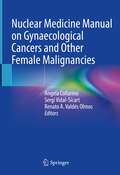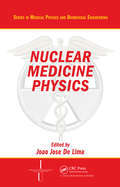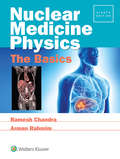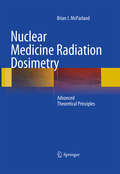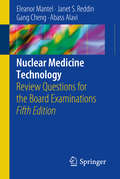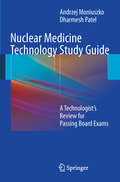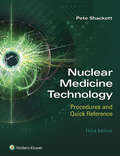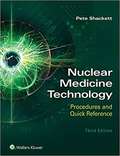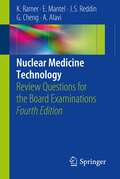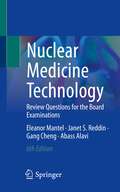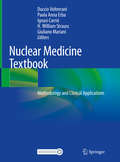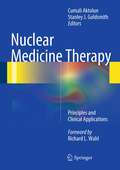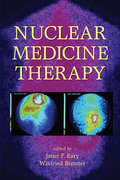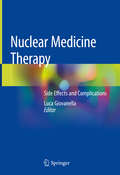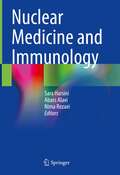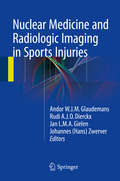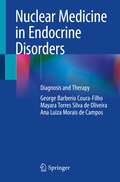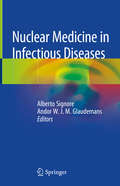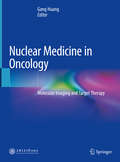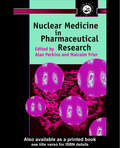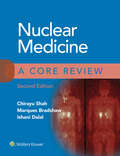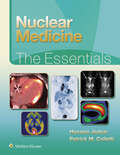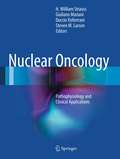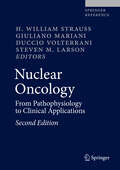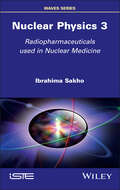- Table View
- List View
Nuclear Medicine Manual on Gynaecological Cancers and Other Female Malignancies
by Sergi Vidal-Sicart Renato A. Valdés Olmos Angela CollarinoThis book is mainly intended for residents and young physicians in Nuclear Medicine, Oncology and Gynaecology, as well as other professionals interested in this area. It covers the application of several relevant nuclear medicine procedures for malignancies affecting the female reproductive system and the breast. To date, there has never been a nuclear medicine textbook specifically focused on this topic, which this work seeks to remedy. In recent years, certain nuclear medicine procedures have proven to be extremely valuable for the diagnosis and staging of gynaecological malignancies and breast cancer. The book provides a comprehensive and structured review of these procedures, accompanied by a summary of the respective issues, making it a valuable asset for students, instructors and practitioners alike.
Nuclear Medicine Physics (Series in Medical Physics and Biomedical Engineering)
by J. J. Pedroso de LimaEdited by a renowned international expert in the field, Nuclear Medicine Physics offers an up-to-date, state-of-the-art account of the physics behind the theoretical foundation and applications of nuclear medicine. It covers important physical aspects of the methods and instruments involved in modern nuclear medicine, along with related biological
Nuclear Medicine Physics: The Basics (Radiology Pocket Atlas Ser.)
by Ramesh Chandra Arman RahmimPart of the renowned The Basics series, Nuclear Medicine Physics helps build foundational knowledge of how and why things happen in the clinical environment. Ideal for board review and reference, the 8th edition provides a practical summary of this complex field, focusing on essential details as well as real-life examples taken from nuclear medicine practice. New full-color illustrations, concise text, essential mathematical equations, key points, review questions, and useful appendices help you quickly master challenging concepts in nuclear medicine physics.
Nuclear Medicine Radiation Dosimetry
by Brian J McparlandComplexities of the requirements for accurate radiation dosimetry evaluation in both diagnostic and therapeutic nuclear medicine (including PET) have grown over the past decade. This is due primarily to four factors: Growing consideration of accurate patient-specific treatment planning for radionuclide therapy as a means of improving the therapeutic benefit, development of more realistic anthropomorphic phantoms and their use in estimating radiation transport and dosimetry in patients, Design and use of advanced Monte Carlo algorithms in calculating the above-mentioned radiation transport and dosimetry which require the user to have a thorough understanding of the theoretical principles used in such algorithms, their appropriateness and their limitations, increasing regulatory scrutiny of the radiation dose burden borne by nuclear medicine patients in the clinic and in the development of new radiopharmaceuticals, thus requiring more accurate and robust dosimetry evaluations. An element common to all four factors is the need for precise radiation dosimetry in nuclear medicine, which is fundamental to the therapeutic success of a patient undergoing radionuclide therapy and to the safety of the patients undergoing diagnostic nuclear medicine and PET procedures. As the complexity of internal radiation dosimetry applied to diagnostic and therapeutic nuclear medicine increases, this book will provide the theoretical foundations for: enabling the practising nuclear medicine physicist to understand the dosimetry calculations being used and their limitations, allowing the research nuclear medicine physicist to critically examine the internal radiation dosimetry algorithms available and under development; and providing the developers of Monte Carlo codes for the transport of radiation resulting from internal radioactive sources with the only comprehensive and definitive.
Nuclear Medicine Technology
by Janet S. Reddin Eleanor Mantel Gang Cheng Abass AlaviThis book prepares students and technologists for registry examinations in nuclear medicine technology by providing practice questions and answers with detailed explanations, as well as a mock registry exam. The questions are designed to test the basic knowledge required of nuclear medicine technologists, as well as the practical application of that knowledge. The topics covered closely follow the content specifications and the components of preparedness as published by the certification boards. This 4th edition includes expanded coverage of positron emission tomography and other new procedures and practices in the field of nuclear medicine and molecular imaging.
Nuclear Medicine Technology Study Guide
by Andrzej Moniuszko Dharmesh PatelNuclear Medicine Technology Study Guide presents a comprehensive review of nuclear medicine principles and concepts necessary for technologists to pass board examinations. The practice questions and content follow the guidelines of the Nuclear Medicine Technology Certification Board (NMTCB) and American Registry of Radiological Technologists (ARRT), allowing test takers to maximize their success in passing the examinations. The book is organized by sections of increasing difficulty, with over 600 multiple-choice questions covering all areas of nuclear medicine, including radiation safety; radionuclides and radiopharmaceuticals; instrumentation and quality control; patient care; and diagnostic and therapeutic procedures. Detailed answers and explanations to the practice questions follow. Supplementary chapters will include nuclear medicine formulas, numbers, and a glossary of terms for easy access by readers. Additionally, test-taking strategies are covered.
Nuclear Medicine Technology: Procedures And Quick Reference
by Pete ShackettCompletely updated with the latest advances in imaging technology, this quick-reference manual is the only procedures guide specifically geared to nuclear medicine technologists. A concise, easy-to-read bulleted outline format provides clear, step-by-step instructions for 61 scan procedures, including listings of possible artifacts and problems that may arise during each scan. Detailed anatomic illustrations clarify anatomy and body systems, and Patient History sections enhance students’ patient communication and education capabilities.
Nuclear Medicine Technology: Procedures And Quick Reference
by Pete ShackettMaster essential procedures with ease and build the clinical confidence for success in practice with this concise, easy-to-use guide. Step-by-step instructions walk you through 65 key scan procedures—complete with listings of possible artifacts and issues that may arise during each scan with added relevant information for each scan—to help you ensure the most effective imaging outcomes. Students of Medicine and Physicians may quickly review the indications, contraindications, expected normal and abnormal findings for any included test. Updated content reflects the latest imaging technology and the most clinically relevant scanning procedures. Enhanced design makes key content more accessible. Updated suggested readings familiarize you with the latest clinical literature in nuclear medicine technology. Concise, bulleted outline format guides you step-by-step through 65 essential scan procedures. Complete list of indications, contraindications, normal and abnormal findings for all studies listed in the book. Detailed anatomic illustrations reinforce your understanding of human anatomy and body systems. Patient History sections help you ensure effective patient communication before exams and during scanning. An extensive quick-reference section provides fast access to conversion tables, radiopharmaceutical dose ranges, pediatric dosing, anatomic drawings, standard drug interventions, lab tests, language translations, thyroid therapy information, billing codes, and reproducible patient history sheets for over 25 scans. eBook available for purchase. Fast, smart, and convenient, today’s eBooks can transform learning. These interactive, fully searchable tools offer 24/7 access on multiple devices, the ability to highlight and share notes, and more.
Nuclear Medicine Technology: Review Questions for the Board Examinations
by Janet S. Reddin Eleanor Mantel Gang Cheng Abass Alavi Karen RamerThis book prepares students and technologists for registry examinations in nuclear medicine technology by providing practice questions and answers with detailed explanations, as well as a mock registry exam. The questions are designed to test the basic knowledge required of nuclear medicine technologists, as well as the practical application of that knowledge. The topics covered closely follow the content specifications and the components of preparedness as published by the certification boards. This 4th edition includes expanded coverage of positron emission tomography and other new procedures and practices in the field of nuclear medicine and molecular imaging.
Nuclear Medicine Technology: Review Questions for the Board Examinations
by Janet S. Reddin Eleanor Mantel Gang Cheng Abass AlaviThis textbook now published in its 6th edition prepares students and technologists for registry examinations in nuclear medicine technology by providing practice questions and answers with detailed explanations, as well as a mock registry exam. The questions are designed to test the basic knowledge required of nuclear medicine technologists, as well as the practical application of that knowledge. The topics covered closely follow the content specifications and the components of preparedness as published by the certification boards. This new edition now includes new tracers for diagnostic imaging and therapeutic applications as well as other newly approved procedures. Coverage of positron emission tomography and hybrid multimodality imaging in the field of nuclear medicine and molecular imaging has also been expanded.
Nuclear Medicine Textbook: Methodology and Clinical Applications
by Duccio Volterrani H. William Strauss Giuliano Mariani Paola Anna Erba Ignasi CarrióBuilding on the traditional concept of nuclear medicine, this textbook presents cutting-edge concepts of hybrid imaging and discusses the close interactions between nuclear medicine and other clinical specialties, in order to achieve the best possible outcomes for patients. Today the diagnostic applications of nuclear medicine are no longer stand-alone procedures, separate from other diagnostic imaging modalities. This is especially true for hybrid imaging guided interventional radiology or surgical procedures. Accordingly, today’s nuclear medicine specialists are actually specialists in multimodality imaging (in addition to their expertise in the diagnostic and therapeutic uses of radionuclides). This new role requires a new core curriculum for training nuclear medicine specialists. This textbook is designed to meet these new educational needs, and to prepare nuclear physicians and technologists for careers in this exciting specialty.
Nuclear Medicine Therapy
by Cumali Aktolun Stanley J. GoldsmithNuclear Medicine Therapy presents the state of the art in targeted radionuclide therapy, both in clinical practice and contemporary clinical investigation and trials. With contributions from an internationally-distinguished group of physicians and scientists, the book is devoted entirely to the use of nuclear medicine techniques and technology for therapy of malignant and benign diseases. Individual chapters cover the scientific principles and clinical applications of radionuclide therapy and the state of clinical trials of agents currently under investigation in the therapy of tumors involving virtually every organ system. Due to overlapping interest in techniques, indications, and clinical use, the development of radionuclide therapy attracts considerable input from other medical specialists whose collaboration is essential, including radiation and medical oncologists, hematologists, diagnostic radiologists, hepatologists, endocrinologists, and rheumatologists. And because radionuclide therapy is a rapidly evolving field of nuclear medicine, it is the aim of this volume to appeal to all specialists involved in targeted radionuclide therapy and to contribute to the standardization of the practice globally.
Nuclear Medicine Therapy
by Janet F. Eary Winfried BrennerOne in three of the 30 million Americans who are hospitalized are diagnosed or treated with nuclear medicine techniques. This text provides a succinct overview and detailed set of procedures and considerations for patient therapy with unsealed radioactivity sources. Serving as a complete literature reference for therapy with radiopharmaceuticals c
Nuclear Medicine Therapy: Side Effects and Complications
by Luca GiovanellaThis book considers how Nuclear Medicine treatments have been further developed in the past several years and are now widely applied in clinical practice, especially in oncological patients, in addition to radioiodine therapy for various thyroid diseases. These treatments are very effective when properly indicated, but side effects and complications specifically related to the radioactive drugs and other potential clinical problems should also be considered, since other treatments, e.g. chemotherapy or radiotherapy, are frequently administered before, simultaneously with and/or after radionuclide therapies. Consequently, cumulative toxicities and treatment interactions must be considered, and physicians prescribing treatments should be capable of preventing (when possible) and properly diagnosing and treating such side effects and complications. Accordingly, expertise in radionuclide therapy and extensive clinical expertise are required to appropriately manage critical cases. This book provides essential information on the physiopathology and radiopharmacy of radionuclide treatments and addresses potential side effects and complications by providing a rapid consultation guide for clinicians: synopses, diagnostic flow-charts and treatment schedules for a range of nuclear medicine treatments
Nuclear Medicine and Immunology
by Abass Alavi Nima Rezaei Sara HarsiniThis book explores the close connection between immunology and nuclear medicine, which has led to radioimmunoimaging and radioimmunotherapy (RIT). Molecular imaging with positron emission tomography (PET) and single-photon emission computed tomography (SPECT) is increasingly being used to diagnose, characterize, and monitor disease activity in the context of inflammatory disorders of known and unknown etiology, such as sarcoidosis, atherosclerosis, vasculitis, inflammatory bowel disease, rheumatoid arthritis, and degenerative joint disease. The first chapters discuss the various radiopharmaceutical agents and radiolabeled preparations that have been employed in inflammation imaging. Of these, FDG-PET imaging has been shown to have the great value in the detection of inflammation and has become the centerpiece of several initiatives over the last several years. This very powerful technique will play an increasingly important role in the management of patients with inflammatory conditions in the future. The book also explores the growing role of nuclear medicine and molecular imaging in the diagnosis and treatment of cancer. The rapid pace of change has been fueled by advances in our understanding of tumor biology, on the one hand, and the development of specifically targeted medical therapies, diagnostic agents, and radiotherapies, on the other. Written by leading international experts in the field, this book is an invaluable tool for nuclear medicine physicians, radiologists, oncologists, and immunologists.
Nuclear Medicine and Radiologic Imaging in Sports Injuries
by Rudi A.J.O. Dierckx Andor W.J.M. Glaudemans Jan L.M.A. Gielen Johannes Hans ZwerverThis comprehensive book describes in detail how nuclear medicine and radiology can meet the needs of the sports medicine physician by assisting in precise diagnosis, clarification of pathophysiology, imaging of treatment outcome and monitoring of rehabilitation. Individual sections focus on nuclear medicine and radiologic imaging of injuries to the head and face, spine, chest, shoulder, elbow and forearm, wrist and hand, pelvic region, knee, lower leg, ankle and foot. The pathophysiology of sports injuries frequently encountered in different regions of the body is described from the perspective of each specialty, and the potential diagnostic and management benefits offered by the new hybrid imaging modalities - SPECT/CT, PET/CT, and PET/MRI - are explained. In addition, a range of basic and general issues are addressed, including imaging of the injuries characteristic of specific sports. It is hoped that this book will promote interdisciplinary awareness and communication and improve the management of injured recreational or elite athletes.
Nuclear Medicine in Endocrine Disorders: Diagnosis and Therapy
by George Barberio Coura-Filho Mayara Torres Silva de Oliveira Ana Luiza Morais de CamposThis book presents up-to-date information on the general principles of diagnostic and therapeutic nuclear medicine in the context of endocrinology. The content is divided into six parts. Section I examines general aspects of radiopharmaceuticals, scintigraphy, single-photon emission computed tomography (SPECT), positron emission tomography (PET), radionuclide therapies and radioguided surgery. Section II discusses diagnostic applications in benign thyroid diseases and evaluation of thyroid nodules. Section III gives an overview of the management of parathyroid diseases. Section IV presents diagnostic techniques in well-differentiated thyroid cancer. Section V addresses procedures and therapy in adrenal benign and malignant disorders (phaechromocytomas and paragangliomas). Lastly, the diagnosis and treatment of neuroendocrine tumors are featured in Section VI. Nuclear Medicine in Endocrine Disorders: Diagnosis and Therapy is intended for non-specialists in nuclear medicine working in the field of endocrinology, and is also a valuable resource for researchers and students.
Nuclear Medicine in Infectious Diseases
by Alberto Signore Andor W. J. M. GlaudemansThis book is designed as a reference manual that is exceptional in systematically discussing every aspect of nuclear medicine imaging of infections, with careful explanation of the most up-to-date concepts and recent guidelines on diagnostic flowcharts as shared between the EANM, ESR, ESNR, ESCMID, ESC, EACVI, ECCO, ESGAR and EBJIS. It is truly comprehensive, describing all methods, all acquisition parameters, and all interpretation criteria in all infectious diseases. The early chapters discuss currently available radiopharmaceuticals and nuclear medicine imaging technologies, including the hybrid modalities SPECT/CT, PET/CT, and PET/MRI. The remainder of the book is devoted to the nuclear medicine imaging of infections at different body sites as well as fever of unknown origin, fungal infections, and tuberculosis and AIDS-associated infections. Infections represent a real emergency globally, and early diagnosis and treatment follow-up will continue to pose huge challenges. In this context, Nuclear Medicine in Infectious Diseases will be a superb asset for nuclear medicine and infectious disease specialists and other clinicians everywhere.
Nuclear Medicine in Oncology: Molecular Imaging and Target Therapy
by Gang HuangThis book introduces molecular imaging and Target Therapy in various cancers. The first part is the subjects and primary focused on the basics of nuclear physics, radiation dosimetry, nuclear medicine equipment and small animal imaging equipment. The second part is about the radiopharmaceutical and commonly used clinical radiopharmaceuticals, including positron emission imaging agent, single photon emission imaging agent, and radionuclide therapy agents as well as their radioactive preparation, quality control, and a brief clinical application were included. Also, this part introduces a number of new imaging agents which were potential value of clinical applications. In the third part, the clinical application of the conventional imaging agent 18F-FDG in different tumors and neurodegenerative diseases and 18F-Dopa imaging in the nervous system are discussed. Besides the clinical applications of 99mTc labeled radiopharmaceuticals in parathyroid disease, coronary heart disease, myocardial infarction, sentinel lymph node, metastatic bone tumors, liver and gallbladder disease in children are introduced. Finally, the applications of radionuclide 131I on treatments of Graves' disease and differentiated thyroid cancer and metastases are investigated respectively. This book is a useful reference for professionals engaged in nuclear medicine and clinical research, including clinical nuclear medicine physicians, nuclear medicine engineers and nuclear medicine pharmacists.
Nuclear Medicine in Pharmaceutical Research
by A. C. Perkins M. FrierThis text defines the role and scope of nuclear medicine imaging techniques (gamma scintigraphy) in pharmaceutical research, giving information from clinical trial data.
Nuclear Medicine: A Core Review (A\core Review Ser.)
by Chirayu Shah Marques Bradshaw Ishani DalalPrepare for success on the nuclear medicine component of the radiology Core Exam! Nuclear Medicine: A Core Review, 2nd Edition, by Drs. Chirayu Shah, Marques Bradshaw, and Ishani Dalal is an up-to-date, practical review tool written specifically for the Core Exam. This helpful resource contains 300 image-rich, multiple-choice questions with detailed explanations of right and wrong answers. Fully revised content, high-yield tables for easy review, and additional eBook questions ensure you’re ready for the Core Exam or recertification exam. This revised edition includes one hundred new questions with a dedicated physics chapter. Questions removed from the previous edition are still available for review in the eBook.
Nuclear Medicine: The Essentials
by Hossein Jadvar Patrick M. CollettiPerfect for residents and fellows to use during rotations, or as a quick review for practicing radiologists and nuclear medicine physicians, Nuclear Medicine: The Essentials is a complete, concise overview of the most important knowledge in this challenging and evolving field. Each chapter begins with learning objectives and ends with board-style questions that help you focus your learning. A self-assessment examination in print and additional self-assessment material online test your mastery of the content and prepare you for exams.
Nuclear Oncology
by Duccio Volterrani H. William Strauss Giuliano Mariani Steven M. LarsonThis book provides the reader with a comprehensive understanding of both the basic principles and the clinical applications of nuclear oncology imaging techniques. The authors have assembled a distinguished group of leaders in the field who provide valuable insight on the subject. The book also includes major chapters on the cancer patient and the pathophysiology of abnormal tissue, the evaluation of co-existing disease, and the diagnosis and therapy of specific tumors using functional imaging studies. Each chapter is heavily illustrated to assist the reader in understanding the clinical role of nuclear oncology in cancer disease therapy and management.
Nuclear Oncology
by Duccio Volterrani H. William Strauss Giuliano Mariani Steven M. LarsonThis book discusses the role of nuclear medicine in the diagnosis, staging, and treatment of patients with specific cancers. It presents the incidence, pathophysiologic and clinical aspects of the disease, the use of nuclear imaging in diagnosis, staging requirements, management of specific tumors, and surveillance after primary treatment of cancers. It addresses the various diagnostic/therapeutic options that are currently available or are most likely to become available in the near future according to a prioritized approach, thereby keeping to a minimum the number of diagnostic imaging procedures the patient is expected to undergo. Topics include basic science, clinical applications, radionuclide therapy, radioguided surgery, heart disease in the cancer patient, and adverse effects of cancer therapy. Each clinical chapter discusses the radionuclide procedures within an integrated framework, thereby identifying the information required for effective treatment of specific tumors. The book concludes with a series of cases that define and expand the didactic material in the clinical application chapters. Thoroughly updated and revised, the second edition incorporates advances in imaging and therapy and features the current staging guidelines of the American Joint Committee on Cancer. With contributions from a group of internationally distinguished practitione rs, Nuclear Oncology: From Pathophysiology to Clinical Applications, Second Edition, is a valuable reference for nuclear medicine physicians, radiologists, medical and surgical oncologists, and other clinicians involved in the care and management of cancer patients.
Nuclear Physics 3: Radiopharmaceuticals Used in Nuclear Medicine (ISTE Invoiced)
by Ibrahima SakhoNuclear Physics 3 presents the applications of various radioisotopes in nuclear medicine, with a focus on radiological imaging methods such as X-rays, γ scintigraphy – PET – MRI and ultrasound, which do not exploit the properties of radiopharmaceuticals. The book then presents the physicochemical and pharmacological properties of radiopharmaceuticals labeled with 99mTc, 201Tl, 18mKr, 18F and the radioisotopes 123I, 125I and 131I used in nuclear medicine. The production chains for the radiotracers studied, as well as their main emissions, are then described in detail, followed by a study of the clearance mechanisms of the radiopharmaceuticals under consideration. Finally, the book describes the principles of myocardial, pulmonary, bone, thyroid, renal and gastric emptying scans using the properties of the radiotracers studied, as well as the principles of prostate brachytherapy using iodine-125 implants and prostate chemotherapy.
